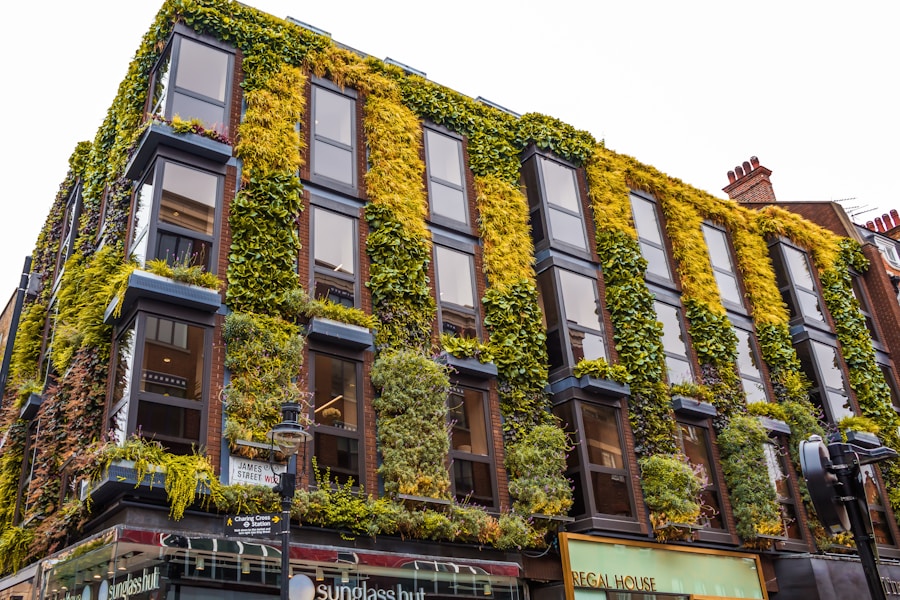Vertical gardening has become increasingly popular in recent years, and for good reason. There are numerous benefits to growing plants vertically, whether you have limited outdoor space or simply want to add a unique and eye-catching element to your garden. One of the main advantages of vertical gardening is that it allows you to maximize your growing space. By utilizing vertical surfaces such as walls, fences, and trellises, you can grow a wide variety of plants without taking up valuable ground space. This is especially beneficial for those who live in urban areas or have small yards, as it allows them to make the most of their limited outdoor space.
In addition to maximizing space, vertical gardening can also help improve air quality and reduce energy costs. Plants naturally absorb carbon dioxide and release oxygen, which can help improve the air quality around your home. By growing plants vertically, you can create a living wall that acts as a natural air purifier. Furthermore, vertical gardens can provide insulation for your home, helping to reduce energy costs by keeping your living space cooler in the summer and warmer in the winter. Overall, vertical gardening offers a range of benefits that make it an attractive option for both experienced gardeners and beginners alike.
How to Get Started with Vertical Gardening
If you’re interested in trying your hand at vertical gardening, there are a few key steps to keep in mind as you get started. The first step is to assess your outdoor space and determine where you want to create your vertical garden. Look for areas that receive adequate sunlight and have access to water, as these are essential for the success of your plants. Once you’ve identified a suitable location, you can begin to plan out the design of your vertical garden. Consider the types of plants you want to grow and how much space they will need to thrive. You may also want to think about incorporating elements such as trellises, hanging baskets, or wall-mounted planters to add visual interest to your garden.
After you’ve planned out your vertical garden, it’s time to start preparing the space and selecting your plants. Make sure to properly prepare the surface where you’ll be installing your vertical garden, whether it’s a wall, fence, or other structure. This may involve cleaning the surface, adding a support system such as a trellis or wire grid, and ensuring that the area has proper drainage. Once the space is ready, you can begin selecting the plants that will thrive in your vertical garden. Consider factors such as sunlight requirements, water needs, and the mature size of the plants to ensure that they will be well-suited for your vertical garden. With careful planning and preparation, you can create a stunning and functional vertical garden that will enhance your outdoor space.
Choosing the Right Plants for Vertical Gardening
When it comes to choosing plants for your vertical garden, there are a few key factors to consider in order to ensure their success. One of the most important considerations is the amount of sunlight that your vertical garden receives. Some plants thrive in full sun, while others prefer partial or full shade. Take note of the amount of sunlight that your chosen location receives throughout the day, and select plants that are well-suited to those conditions. Additionally, consider the mature size of the plants you choose, as you’ll want to ensure that they have enough space to grow vertically without becoming overcrowded.
In addition to sunlight requirements and mature size, it’s also important to consider the water needs of the plants you select for your vertical garden. Some plants require more frequent watering than others, so be sure to choose plants that are well-suited to the amount of water that your vertical garden will receive. You may also want to consider incorporating a drip irrigation system or self-watering planters to help ensure that your plants receive adequate moisture. Finally, think about the overall aesthetic that you want to achieve with your vertical garden. Consider selecting a mix of plants with different colors, textures, and growth habits to create a visually appealing and dynamic display. By carefully considering these factors, you can choose the right plants for your vertical garden and set yourself up for success.
Creative Vertical Gardening Ideas for Limited Outdoor Space
Limited outdoor space doesn’t have to limit your gardening options. With a bit of creativity and ingenuity, you can create a stunning vertical garden that makes the most of your available space. One creative idea for vertical gardening in limited outdoor space is to utilize a living wall system. Living walls are vertical gardens that are made up of modular panels filled with plants and soil, which can be attached to an exterior wall or freestanding structure. These systems allow you to grow a wide variety of plants in a small footprint, making them an ideal option for those with limited outdoor space.
Another creative idea for vertical gardening in limited outdoor space is to repurpose everyday items as planters. For example, you can use old pallets to create a vertical herb garden, or repurpose shoe organizers as hanging planters. By thinking outside the box and finding unique ways to incorporate plants into your outdoor space, you can create a one-of-a-kind vertical garden that adds beauty and functionality to your home. Additionally, consider incorporating elements such as trellises, arbors, or hanging baskets to add visual interest and dimension to your vertical garden. With a bit of creativity and resourcefulness, you can create a stunning vertical garden that makes the most of your limited outdoor space.
DIY Vertical Gardening Projects
If you’re interested in trying your hand at DIY vertical gardening projects, there are plenty of options to choose from that can help you create a unique and functional vertical garden. One popular DIY project for vertical gardening is creating a pallet garden. Pallets can be repurposed into vertical planters by adding shelves or pockets for planting, allowing you to grow a variety of herbs, flowers, or vegetables in a small footprint. Another popular DIY project for vertical gardening is creating a hanging gutter garden. By repurposing old gutters as planters and hanging them vertically, you can create a space-saving garden that adds visual interest to your outdoor space.
In addition to pallet gardens and hanging gutter gardens, there are plenty of other DIY projects for vertical gardening that you can try. For example, you can create a trellis or wire grid system for climbing plants such as peas or cucumbers, or repurpose old containers into hanging planters for flowers or herbs. You may also want to consider incorporating elements such as wall-mounted planters or living wall systems into your DIY vertical gardening projects. With a bit of creativity and resourcefulness, you can create a stunning and functional vertical garden that adds beauty and greenery to your outdoor space.
Tips for Maintaining a Vertical Garden
Once you’ve created your vertical garden, it’s important to take steps to ensure that it thrives over time. One key aspect of maintaining a vertical garden is regular watering. Because vertical gardens are often exposed to more wind and sunlight than traditional gardens, they may require more frequent watering to keep the plants healthy and hydrated. Consider incorporating a drip irrigation system or self-watering planters into your vertical garden to help ensure that your plants receive adequate moisture.
In addition to regular watering, it’s important to keep an eye on the health of your plants and address any issues as they arise. Check for signs of pests or disease regularly, and take steps to address any problems before they become more serious. You may also want to consider fertilizing your plants periodically to help promote healthy growth and flowering. Finally, consider pruning and trimming your plants as needed to help maintain their shape and encourage new growth. By taking these steps to maintain your vertical garden, you can ensure that it continues to thrive and bring beauty to your outdoor space.
Vertical Gardening for Urban Living: Success Stories and Inspiration
Vertical gardening has become increasingly popular among urban dwellers who are looking for creative ways to bring greenery into their living spaces. There are countless success stories of individuals and communities who have embraced vertical gardening as a way to add beauty and functionality to their urban environments. One inspiring example is the Bosco Verticale in Milan, Italy, which is a pair of residential towers that are covered in over 900 trees and 5,000 shrubs. This innovative project not only adds greenery to the city skyline but also helps improve air quality and reduce energy costs for residents.
Another success story in urban vertical gardening is the High Line in New York City, which is an elevated park built on an abandoned railway line. The High Line features an array of native plants and trees that have been carefully selected to thrive in an urban environment, creating a unique green space in the heart of the city. These success stories serve as inspiration for urban dwellers who are looking for creative ways to incorporate greenery into their living spaces. Whether it’s through large-scale projects like Bosco Verticale or community initiatives like the High Line, there are countless ways that vertical gardening can enhance urban living and bring beauty and nature into city environments.
In conclusion, vertical gardening offers numerous benefits for both experienced gardeners and beginners alike. By maximizing growing space, improving air quality, reducing energy costs, and adding visual interest to outdoor spaces, vertical gardening has become an attractive option for those with limited outdoor space or a desire for a unique gardening experience. With careful planning and preparation, choosing the right plants, creative ideas for limited outdoor space, DIY projects, maintenance tips, and inspiration from successful urban projects like Bosco Verticale and the High Line in New York City, anyone can create a stunning and functional vertical garden that enhances their living environment. Whether you’re looking for ways to make the most of limited outdoor space or simply want to add beauty and greenery to your home, vertical gardening offers endless possibilities for creativity and enjoyment.



